Ten reasons Japan’s bullet trains still put others to shame
By Danielle Demetriou
Sumo, skyscrapers, sushi – and Shinkansen. Japan’s legendary fleet of white-nosed bullet trains, which smoothly criss-cross the country at scene-blurring speeds, has emerged as one of the most enduring symbols of the land of the rising sun.
This month the nation’s much-loved bullet train, known as Shinkansen, celebrated its 60th birthday. Timelessly sleek, clean, comfortable and punctual enough to set your watch by, Japan’s bullet trains are in a class of their own when it comes to rail travel standards.
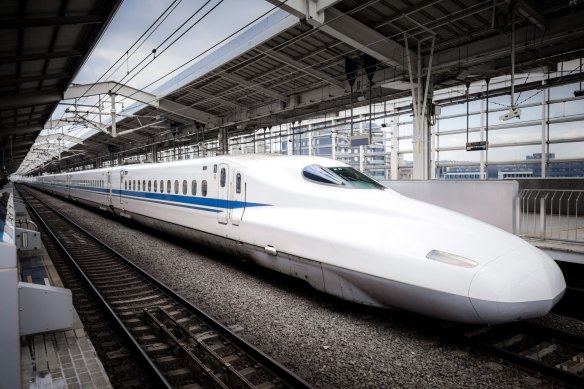
Japan’s Shinkansen is sleek, clean and comfortable, not to mention fast.Credit: iStock
It was at 6am on 1 October 1964 – just days ahead of the opening of the Tokyo Olympics – that Japan made rail history as it unveiled to the world its ground-breaking reimagining of trains for the future.
Two inaugural white bullet trains travelled 515 kilometres between Tokyo and Osaka, one departing from each station, arriving a precise four hours later at 10am – marking a significant improvement from the previous journey length of 6.5 hours (today it takes just over two hours).
This historic journey, the trains slicing at high speed through Japanese countryside, reflected not only a new pinnacle in rail technology – more deeply, it symbolised Japan’s bold post-war recovery and reinvention as a rising economic superpower, a status confirmed further with the success of the ensuing Tokyo Olympics.
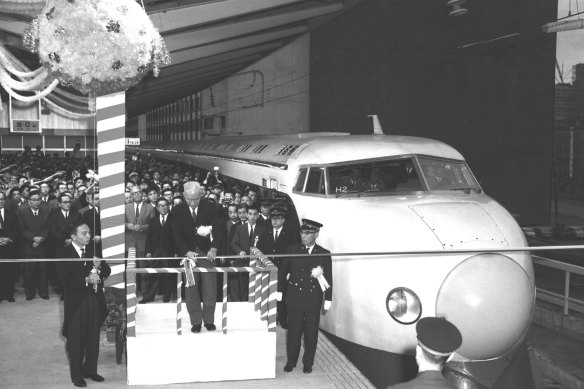
1st October 1964 – The bullet train network begins operating between Tokyo and Osaka, just ahead of the opening of the Tokyo Olympics.Credit: Alamy
Since then, the bullet train network has steadily inched its way across the Japanese archipelago, stretching up to the northernmost island Hokkaido and across the southernmost Kyushu region.
Today, the Shinkansen continues to shine brightly on the Japanese landscape, for both locals and inbound tourists alike, with its flawless travel record of zero passenger fatalities and average delays of less than a minute.
On-time trains may sound like an oxymoron for Australia’s beleaguered regional commuters. In October, 75 per cent of NSW intercity trains arrived on time. In July the figure was just 71 per cent. Victoria fares a little better, with Vline trains approaching 90 per cent punctuality, while Queensland is worse, with punctuality below 70 per cent for long-distance trains in recent months. Bear in mind Australia is pretty lax when it comes to defining “on time” too – trains are still considered on time if they’re anywhere from six to 15 minutes late.
The Shinkansen meanwhile, is a meticulous work-in-progress: the latest extension opened as recently as March this year, with a new section of the Hokuriku Shinkansen connecting Kanazawa in Ishikawa Prefecture to Tsuruga in Fukui Prefecture, 137 kilometres away.
For many visitors to Japan, travelling on a bullet train is a once-in-a-lifetime highlight, according to James Mundy, PR manager of InsideJapan, a leading independent Japan travel specialist.

The Shinkansen network has average delays of less than a minute.Credit: iStock
“The Shinkansen is as iconic as geisha or Mount Fuji,” he says. “I think that everyone unlocks that train geek within when travelling by train in Japan. The Shinkansen is just so good – not only does it run on time (often to the second), but it is also fast, clean, comfortable, reliable and they just look very sleek.
“All of InsideJapan’s cultural adventures include travel on the Shinkansen and it’s often the best way to get somewhere. Travelling on the bullet train is part of the Japan experience itself. When travelling on mainland Japan, travelling on the Shinkansen is frequently a better option than flying and we encourage all our travellers to give it a go.”
Meanwhile, James Greenfield, managing director of specialist tour operator Japan Journeys, highlights two tips for visitors: “Firstly, use the ticket machines rather than queuing up at ticket offices. If you have a JR Pass (Japan Rail Pass) you can also use the machines by scanning the QR code.
“Plus, if you’re a Hello Kitty fan, look out for the Hello Kitty bullet train that runs once a day on some routes.”
Here are 10 impressive features of the Shinkansen.
1. All about speed
The nation’s fleet of high-tech (and regularly updated) bullet trains can currently travel at top speeds of 320 km/h. They can no longer claim to be the fastest in the world, having been eclipsed by China’s blink-and-you-miss-it fast Maglevs – yet Japan’s bullet trains remain an enduring symbol of the nation’s cutting-edge rail technology capabilities.
2. Mount Fuji views
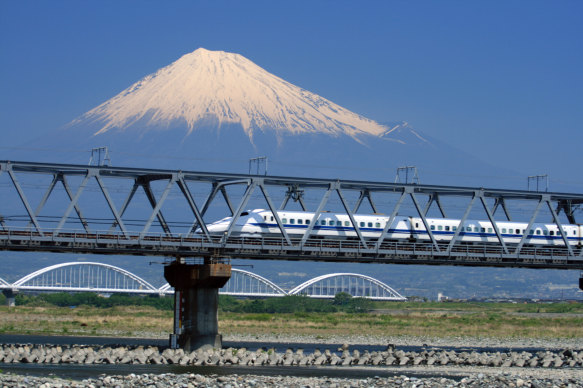
Make sure you get a seat on the right-hand side if travelling from Tokyo to Kyoto.Credit: iStock
Keen to catch sight of Mount Fuji’s looming triangular form surrounded by rice fields through a bullet train window? When travelling from Tokyo to Kyoto, make sure to book a window seat on the right hand side (or nab one on the left if heading in the opposite direction). Keep an eye out (and fingers crossed for clear skies) around 40 minutes after leaving Tokyo.
3. Spotless as well as speedy
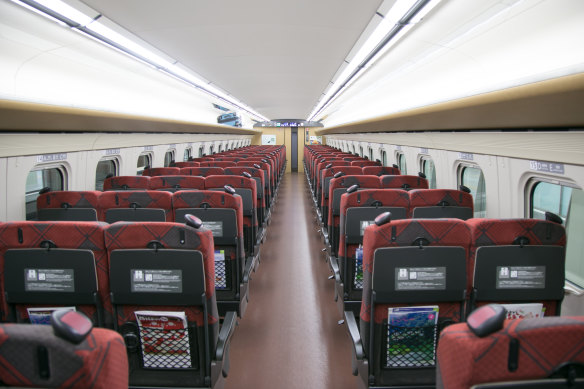
Shinkansen are famously tidy.Credit: iStock
Like pretty much every element of Japanese society, these trains are famously tidy. This is due to meticulously executed cleaning regimes by fleets of workers who flood through the aisles when the train is stopped between stations – resulting in the so-called “seven-minute miracle”. This high-speed cleaning routine on JR-East bullet trains involves crew cleaning over 1000 seats in just seven minutes, with impossibly graceful and fast-paced actions that have become an internet sensation and even the subject of Harvard Business School studies.
4. Tokyo-Osaka
The busiest route in Japan is the Tokaido Shinkansen line which whizzes between the nation’s four biggest cities: Tokyo, Yokohama, Nagoya and Osaka. Today, travelling between Tokyo and Osaka is a lot quicker than the inaugural four-hour journey in 1964, taking as little as two hours 12 minutes, with trains departing every few minutes during the day. The busy line has carried as many as seven billion passengers over the past six decades, according to JR Central.
5. Forget autumn leaves
It’s perhaps hard for us to conceptualise, yet punctual bullet trains are the default rather than a rarity in Japan. For JR Central, which operates the busy Tokyo-Osaka route, the average delay time is 0.9 minutes – a figure that includes those caused by earthquakes and other natural disasters (which are generally the only reason trains fail to run on time in Japan – and not a bad excuse for arriving less than a minute late).
6. High-speed design
While the original Shinkansen was designed by iconic Japanese engineer Hideo Shima, a string of more modern designers have helmed the aesthetic evolution of the bullet train since. Among them is Eiji Mitooka – aka the godfather of modern train design – whose swishy new Nishi Kyushu Shinkansen Kamome train I travelled on ahead of its launch in September 2022, soaking up the gold seagull logo, the minimalist exterior lines, the deep sumi charcoal grey textiles with swirly chrysanthemum patterns and swathes of light birch wood.
7. Food rituals
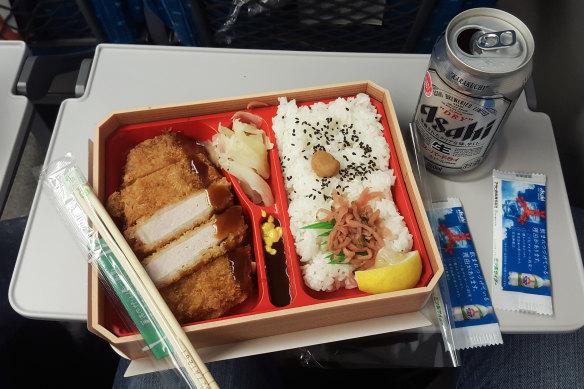
Ekiben are personal bento box meals specifically made to be eaten on board trains.Credit: iStock
A trip on board a bullet train is perhaps incomplete without a pre-journey shop at the station for an ekiben – or a station bento box. These perfectly packaged meals – designed to be savoured in comfort as the train pulls out of the station – typically offer a range of specialty cuisine, from octopus to beef, plus cute kids offerings in train-shaped boxes. Regional bullet train stations are also a great spot to pick up typically quirky Shinkansen souvenirs (anyone for a pair of bullet train socks?).
8. Safety at high speed
The fact that there have been zero passenger fatalities is testimony to their safety. Bullet trains have been equipped with sophisticated earthquake safety systems since 1982 – and the technology is constantly being refined. Earlier this year, new earthquake detection systems were installed on 135 Shinkansen, so emergency brakes can be used to halt the trains faster than ever when a tremblor above 5.5 magnitude hits – reducing the braking time from 3.9 to 1.3 seconds.
9. Omotenashi (hospitality)

Staff on board are unwaveringly polite.Credit: iStock
A train may not be an obvious place to experience Japan’s legendary culture of intuitive hospitality – yet even while sitting on board a Shinkansen, it’s impossible to miss the unwaveringly polite behaviour of impeccably-attired staff, who pause and bow to each carriage while walking through the train.
10. And what’s next?
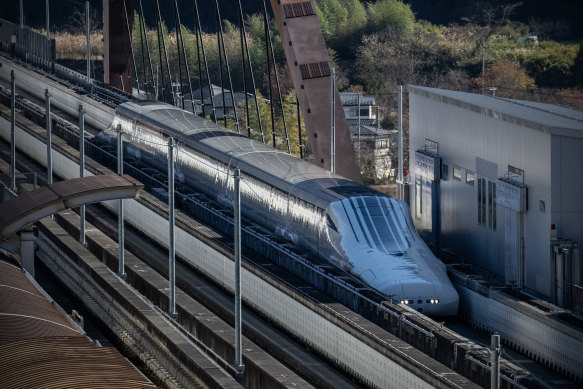
Coming soon: maglev trains that can do 600 km/h.Credit: Getty Images
Sit back and wait for even faster and higher-tech bullet trains: JR Central is currently developing an experimental Maglev Shinkansen known as the L0 Series. The new trains, manufactured by Mitsubishi Heavy Industries with a distinct 15-metre nose for ultra-high speed, have already hit top speeds of 600 km/h during testing, although commercial operational speed will be limited to a still impressive 505 km/h. The trains are due to launch in 2027 between Tokyo and Nagoya.
History of the Shinkansen: Japanese bullet trains
1st October 1964 – The bullet train network begins operating between Tokyo and Osaka, just ahead of the opening of the Tokyo Olympics.
1972 – The bullet train network extends, with the introduction of the Sanyo Shinkansen, which eventually reached Hakata in Fukuoka on Japan’s southern island Kyushu in 1975.
1982 – The Hokuriku Shinkansen is unveiled, creating a high-speed connection between Tokyo and the mountainous Nagano region, which later hosts the 1998 Winter Olympics.
1997 – The Nozomi bullet train service is launched along the Tokaido Shinkansen line, skipping several stops, making it the fastest option between Tokyo and Osaka.
2004 – The Kyushu Shinkansen is launched, connecting Hakata with other spots across the southern island, completed in 2011.
2016 – The bullet train network finally reaches the northernmost island Hokkaido, travelling through an underwater tunnel, making the region’s famed powder snow and scenic wild landscape more accessible overland.
2027 – A new chapter in Japan’s high-speed rail history is due to commence, with the launch of its new L0 Series of Maglev Shinkansen, connecting Tokyo with Nagoya at speeds of up to 505 km/h.
The Telegraph, London
Sign up for the Traveller newsletter
The latest travel news, tips and inspiration delivered to your inbox. Sign up now.